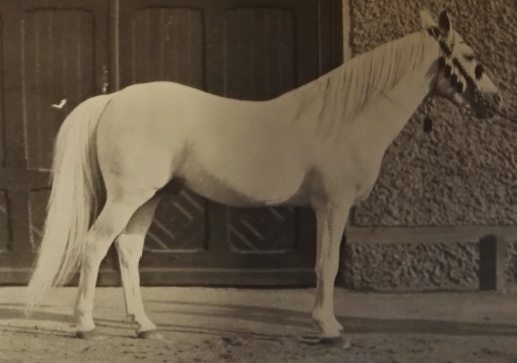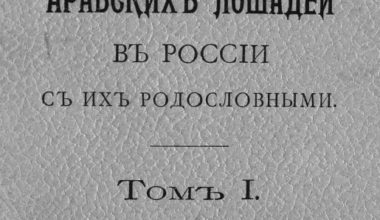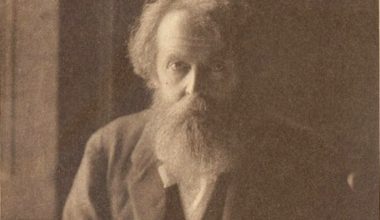Published in the Journal for stud science and horse breeding, by Stud Inspector Veterinärrat Ed. Mieckley, Hauptgestüt Beberbeck,[1] M. & H. Schaper, Hannover, 1910.
Edited by Lyman Doyle. Translated from German to English by Anna Swartz.
Editor’s Note
Mieckley’s short article about Skowronek’s sire Ibrahim is the most complete source on his origin prior to WWI. Edward Skorkowski and Carl Raswan would later use the information contained in this document for as their primary source for Ibrahim’s pedigree.
Mieckley notes “in 1907, the solid-colored white stallion Ibrahim was purchased from an Arabian by the name Hadzi Ali who during a time of unrest fled with two other stallions. According to the Arabian calendar, the stallion was born on the 5th Ramadan 1320 (circa 1900 according to the Christian calendar) in Hedjar near Damaskus and raised by the Bedouin Sheik Obdurahma – Abdulah. The father of the stallion is Hejir, his mother Lalite from the Saglawi breed.”
The translation follows:
For centuries, the area between Lemberg to the Southeast and the Black Sea which nowadays corresponds to the Russian Gouvernements of Volhynia, Podolia, and the Ukraine, is known for breeding a noble horse that is strongly interspersed with oriental blood. To this day, several private studs have maintained the oriental blood in its pure form and developed it to a permanence and performance level that is unrivaled. Messenger rides of 150 km distance and back are not a rarity, when the court Cossack would get on the horse in the evening, ride through the night, and return with the message the next evening on the same horse. Slawuta in the Gouvernement Volhynia is without a doubt one of the more significant studs. It was split up in 1845. One part remained under the previous ownership, the Count Roman Sanguszko, and the other – Antoniny – went in the form of a dowry for Princess Maria Sanguszko to her spouse, the Count Alfred Potocki. Also located in Volhynia, Antoniny today is owned by the Polish magnate Count Joseph Potocki and it is a very modern manor endowed with all comfort. The property includes 55,000 hectares of land, whereby 30,000 hectares are forest. It includes 41 farms, a sugar refinery, 3 distilleries, brick yards, stone and limestone quarries. Other technical enterprises as well as a flourishing livestock breeding operation are also present.
The stud pursues three breeding directions, which are 1. the Arabian pure-breeding program based on 33 pure Arabian mares, 2. the English Thoroughbred breeding program based on 12 English Thoroughbred mares, and 3. the Anglo-Arabian breeding program that is based on 20 Anglo-Arabian mares.
Two original-Arabian stallions at the stud are used to breed the pure-Arabian and Anglo-Arabian mares. Our attached artistic rendering introduces one of the sires – Ibrahim. This stallion succeeds to impress at first sight because of his harmonious build and his extraordinarily strong pedals. He reflects so-called robustness which makes him a regenerator of healthy, strong, efficient producers of military remounts, unridden young horses for the military.
In 1907, the solid-colored white stallion Ibrahim was purchased from an Arabian by the name Hadzi Ali who during a time of unrest fled with two other stallions. According to the Arabian calendar, the stallion was born on the 5th Ramadan 1320 (circa 1900 according to the Christian calendar) in Hedjar near Damaskus and raised by the Bedouin Sheik Obdurahma – Abdulah. The father of the stallion is Hejir, his mother Lalite from the Saglawi breed. His measurements are 155 cm height, 170 cm chest circumference, long bone circumference 20 cm. He has a golden temperament and next to his very fruitful task as a sire, he conforms to any task in front of a wagon or under a rider while having incredibly low maintenance needs. His daily ration is 8 pounds[2] of oats.
We wish to express our gratitude to Mr. Rittmeister[3] Löffler, stud director at Count Podocki’s stud Antoniny, for graciously providing the picture and details about the stallion. Mieckley.
- Beberbeck is one of the five Prussian main studs, including Trakhenen, Neustadt an der Dosse, Graditz, and Altefeld. First written accounts of horse breeding in Beberbeck go back to 1490. The stud was closed in 1929. https://de.wikipedia.org/wiki/Beberbeck, retrieved 03/23/2019. ↑
- The German pound is equal to 500 grams, based on the metric system. ↑
- Rittmeister, title for a ranking officer in the cavalry of the Austro-Hungarian Empire. ↑


